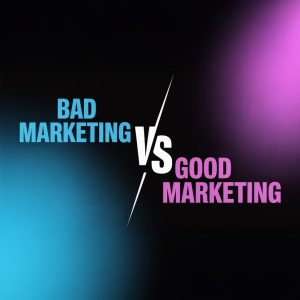Why marketing during a recession is a smart move: retain customer trust, stay visible, and prepare your business for the rebound.
When the economy slows down, businesses tend to cut their marketing budget. But what if this “common sense” approach is actually the fastest way to kill your company’s future? Here’s what the data reveals about the philosophy behind these cuts—and how smart companies use downturns to dominate their competition.
Picture this: It’s 2009, the financial crisis is in full swing, and Starbucks is hemorrhaging money. The coffee giant has just closed nearly 900 locations, and conventional wisdom says it’s time to slash every possible expense—especially marketing. After all, who’s going to buy expensive coffee during a recession?
But instead of following the crowd, Starbucks did something counterintuitive. They doubled down on innovation, launching loyalty programs and mobile payments. They continued investing in their employees while competitors were laying off staff. Most boldly, they opened new locations internationally at a rate of one per day.
The result? Starbucks didn’t just survive the recession—they emerged stronger, with enhanced customer loyalty, expanded global presence, and a competitive moat that persists today.
This story illustrates one of the most dangerous myths in business: that cutting marketing during economic downturns is smart financial management. In reality, it’s often a death sentence disguised as prudent cost control.
The Survival Instinct That Kills Companies
When economic storm clouds gather, something primal happens in corporate boardrooms. The mindset shifts from “How do we grow?” to “How do we survive?” This transformation isn’t just tactical—it’s philosophical, representing a fundamental change in how leadership views the company’s future.
This shift is driven by what behavioral economists call “loss aversion bias”—our tendency to fear losses more than we value equivalent gains. In business terms, this means preserving existing cash feels safer than investing in uncertain future returns. Marketing, with its often intangible and long-term benefits, becomes an easy target.
The Four Pillars of Flawed Thinking
1. The Cash Preservation Trap
When revenue becomes uncertain, companies prioritize maintaining operational liquidity above all else. Marketing gets labeled as “nice-to-have” rather than “must-have,” making it vulnerable to immediate elimination. Recent McKinsey research reveals that company boards demanded an average 8% reduction in marketing expenditures during uncertain times, with some companies slashing budgets by 20% or more.
2. The Attribution Challenge
Unlike operational costs such as manufacturing or logistics, marketing’s impact on revenue is often delayed and difficult to measure precisely. This creates a perception problem where marketing is viewed as discretionary spending rather than essential investment. Traditional accounting methods struggle to capture marketing’s long-term brand-building effects, making it appear expendable when pressure mounts.
3. The Control Illusion
Cutting marketing budgets provides leadership with a sense of control during uncontrollable circumstances. It’s a tangible action that shows immediate bottom-line impact, satisfying the psychological need to “do something” even when that action may be strategically counterproductive.
4. The Quarterly Trap
Public companies face particular pressure to maintain quarterly earnings performance, creating bias toward short-term financial optimization. Marketing investments, which often require multiple quarters to show full returns, conflict with the immediate need to demonstrate cost discipline to analysts and shareholders.
The Shocking Truth: Data Destroys Conventional Wisdom
Here’s where the story gets interesting—and where conventional wisdom gets obliterated by hard data.
Harvard Business Review analyzed 4,700 public companies during the recessions of 1980, 1990, and 2000. Their findings were stunning: while 17% of companies fared very badly (going bankrupt, private, or being acquired), 9% didn’t simply recover—they flourished, outperforming competitors by at least 10% in sales and profits growth.
What separated the winners from the losers? The thrivers maintained strategic investments, including marketing, while others cut everything in sight.
Bain & Company’s study of 700 US companies during the last recession revealed an even more dramatic pattern: twice as many companies made the leap from industry laggards to leaders during the downturn compared to periods of economic calm. More than 20% of companies in the bottom quartile jumped to the top quartile during the recession.
But here’s the kicker: over 70% of firms that secured major gains during the recession sustained those gains through the next boom cycle. Meanwhile, fewer than 30% of those who lost ground were able to regain their positions.
The Marketing Investment Advantage
Companies that maintained or increased marketing spend during downturns consistently achieved superior results:
- 17% compound growth rate for companies that continued investing in growth during the 2008 recession
- 340% sales growth in recovery periods for companies maintaining marketing during past recessions
- Up to 5 years for brands that cut marketing to zero to catch up with those that maintained spend
The evidence is overwhelming: cutting marketing during downturns isn’t just ineffective—it’s actively harmful to long-term competitive position.
The Winners’ Playbook: How Smart Companies Dominate Downturns
So what do successful companies do differently? They follow what McKinsey calls the “investor approach”—treating marketing not as a cost center to be slashed, but as an investment portfolio to be optimized.
Case Study: Procter & Gamble’s Innovation Gambit
When P&G’s sales declined 3% by the end of 2009, they could have followed the crowd and cut marketing across the board. Instead, they implemented an aggressive innovation strategy while maintaining brand investments.
The result? They introduced game-changing products like Tide Pods during the crisis, expanded into emerging markets with localized offerings, and recovered their losses by 2010—setting the stage for even greater growth.
Case Study: Toyota’s Strategic Foresight
While the automotive industry was devastated by the Great Recession, Toyota weathered the storm without laying off a single U.S. manufacturing team member. They anticipated demand for fuel-efficient vehicles, invested in hybrid technology, and expanded globally during the downturn.
The payoff? Toyota emerged stronger with a leading position in hybrid vehicles and reported record profits during the subsequent pandemic despite supply chain challenges.
Case Study: Amazon’s Long-term Vision
During the dot-com crash of 2000, Amazon was just a five-year-old online bookseller facing an uncertain future. Instead of retrenching, they launched Amazon Marketplace for third-party sellers and expanded into new categories like kitchens, travel, and apparel.
That contrarian investment during the downturn laid the foundation for becoming one of the world’s most valuable companies.
The Investor Approach: A New Philosophy for Marketing
The companies that thrive during downturns share a common approach: they treat marketing like a sophisticated investment portfolio rather than a simple expense line item.
The Three-Step Framework
Step 1: Apply Financial Rigor
Instead of across-the-board cuts, successful companies conduct granular analysis of their marketing investments. They identify “bad revenue” with insufficient margins and eliminate inefficient spend while maintaining strategic investments. McKinsey research suggests companies can find 10-20% savings this way.
Step 2: Strategic Reallocation
Rather than simply cutting, winners reallocate savings to high-growth areas. They increase investment where competitors are retreating, maintain critical brand-building activities, and capitalize on reduced media costs and competitive noise.
Step 3: Create Competitive Distance
While competitors go silent, smart companies increase their share of voice, target competitor customers with superior value propositions, and build market positions that persist post-recession.
The Timing Advantage
Research consistently shows that gains or losses made during recessions tend to endure. Companies that act quickly at the beginning of downturns often achieve better results, while those that wait struggle to catch up.
More than two-thirds of companies that made major gains during Bain’s study period did so during the recession itself, not before or after. This timing factor makes early, strategic action crucial for long-term success.
The Implementation Reality: From Theory to Practice
Understanding the theory is one thing; implementing it is another. Successful transformation requires addressing both organizational resistance and practical challenges.
Overcoming the Resistance
Educate Leadership: Help executives understand marketing’s strategic value through clear ROI demonstrations and competitive analysis.
Start with Quick Wins: Identify immediate optimization opportunities that demonstrate value while building confidence in the new approach.
Implement Gradually: Phase in new approaches rather than attempting wholesale transformation overnight.
Measure Everything: Invest in analytics infrastructure that clearly connects marketing activities to business outcomes.
The Four-Phase Implementation
Phase 1 (Months 1-3): Foundation Building
- Audit current marketing portfolio and performance
- Implement basic measurement and ROI tracking
- Educate stakeholders on the investor approach
- Identify immediate optimization opportunities
Phase 2 (Months 3-6): Strategic Reallocation
- Eliminate inefficient spend and reinvest strategically
- Increase investment in areas where competitors are retreating
- Adapt messaging to address recession-specific customer concerns
- Strengthen digital presence and direct customer relationships
Phase 3 (Months 6-12): Growth and Market Capture
- Aggressively pursue market share opportunities
- Launch targeted acquisition campaigns for high-value segments
- Establish thought leadership and market presence
- Build strategic partnerships for competitive advantage
Phase 4 (Months 12+): Recovery Acceleration
- Scale successful initiatives and programs
- Expand into new markets or customer segments
- Consolidate market position gained during recession
- Prepare for rapid scaling when conditions improve
The Choice That Defines Your Future
The evidence is clear, the strategies are proven, and the choice is yours. When the next economic downturn hits—and it will—you can follow the crowd into strategic mediocrity or embrace contrarian thinking for competitive advantage.
Companies that understand this truth don’t just survive recessions; they use them as launching pads for market dominance. They recognize that while others are cutting their way to irrelevance, the real opportunity lies in investing their way to leadership.
The philosophy behind marketing budget cuts during downturns is rooted in fear, short-term thinking, and fundamental misunderstanding of marketing’s strategic value. But the companies that reject this conventional wisdom and embrace the investor approach don’t just weather the storm—they emerge as the new market leaders.
The question isn’t whether you can afford to maintain marketing during a downturn. The question is whether you can afford not to.
Because while your competitors are going silent, your customers are still listening. And the companies that keep talking—strategically, efficiently, and boldly—are the ones that will own the conversation when the economy recovers.
The choice is yours: follow the crowd into the cost-cutting trap, or join the ranks of recession winners who understand that downturns don’t destroy opportunities—they reveal them.
Ready to Become a Recession Winner in Tampa Bay?
If you’re a business owner in the Tampa St. Pete area who’s tired of watching competitors disappear while you struggle to generate consistent leads, it’s time to embrace the investor approach to marketing.
Brain Buzz Marketing specializes in helping Tampa Bay businesses implement the exact strategies outlined in this article. While your competitors are cutting their marketing budgets and going silent, we’ll help you:
✅ Capture Market Share – Increase your visibility when competitors retreat
✅ Generate Quality Leads – Implement data-driven campaigns that deliver measurable ROI
✅ Build Brand Dominance – Establish market leadership while others struggle to survive
✅ Optimize Your Marketing Portfolio – Eliminate wasteful spending and reinvest in growth
✅ Position for Recovery – Set your business up to dominate when the economy rebounds
Don’t let economic uncertainty become your excuse for invisibility. The most successful businesses in Tampa, St. Petersburg, Clearwater, and throughout the Bay area understand that downturns are when market leaders are made.
Ready to turn economic challenges into competitive advantages?
Contact Brain Buzz Marketing today for a free consultation and discover how we can help your Tampa Bay business generate more leads, capture market share, and emerge stronger than ever.
Because while your competitors are cutting their way to irrelevance, smart businesses are investing their way to market leadership.
Contact Brain Buzz Marketing – Your Tampa Bay Lead Generation Experts









